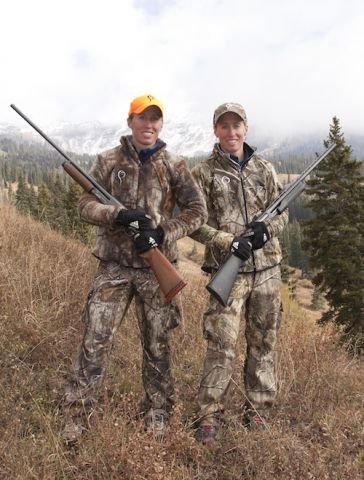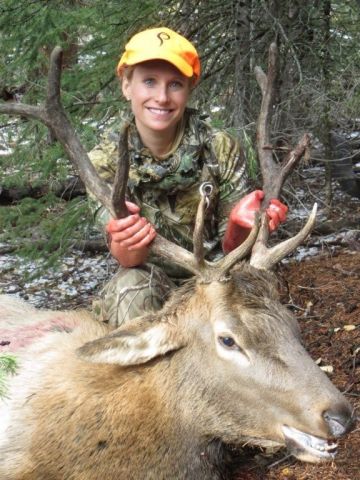To say “time is precious” is an understatement to some. For the past 13 years of her life Christie Barnes, our older sister, has been pursuing a career as a surgeon. She has one more year of residency, at which point she will have received an undergraduate degree in Pre-Med/Biology from Creighton University, a degree from Creighton University, a Masters’ certificate in Physiology from Georgetown, and the title of Surgeon for the field of Otolaryngology (ear, nose, and throat). On top of that, she was given a total of five vacations in 13 years – which usually only consisted of a few days at a time. So, what do you do with your precious vacation time when you only have five days? You go hunting in Colorado, of course.
Hunting is what our family does, and when you’ve had a 13-year hiatus and your freezer is empty, it only seems rational to spend your vacation time participating in a time-honored tradition. The only hang up … you have two days to hunt elk in a unit you’ve never hunted in, and two days to hunt antelope.
So, how do you do that?

The Barnes’ twins love hunting in their home state of Colorado when they’re not training for the next biathlon competition. They are wearing Prois Hunting Apparel. Photo by Jason Baird
Employ your overly eager twin sisters to scout for you! My dad often tells people there is no reason for him to have a hunting dog, because he has us. He’ll send us scouring a mountainside to flush out game. Ahhh … the joys (or downside) of being an Olympic athlete … and the family dog.
We didn’t have much time to scout for her, as we are preparing for the start of our racing season. So, when time is precious and you want the most success out of a hunt, how do you find the animals in the least amount of time? Below, we’ve outlined some tips for scouting for game. Let’s face it, we all don’t have weeks to take off work to scout an area, especially if we are from out of state, but a little scouting in the right way can produce results.
Know before you go.
In other words, have a game plan. Scour maps from the area, the detailed topographic maps that show terrain, drainages, roads, trails, etc. Talk to anyone you know in the area who might have any information on where herds might be or where game may have been spotted.
Check maps.
Look at the maps to determine where roads and trails cut through. If there are a lot of trails and roads in an area, chances are there are tons of people and no game. Find places you can get to, based off your ability and the likelihood that it’s not overly crowded with other hunters, hikers, etc.
Look ahead at the weather.
Check the weather in the area for when you will be there hunting and especially find out what the weather has been like the weeks prior. Ask yourself these questions:
Water. Water. Water.
If you’re planning on hunting out West, you need to be scouting and hunting in areas that have water. Just because the map you are holding shows a creek, doesn’t mean that creek is still running in the fall. If the creek has a glacial lake that sources it, chances are it’ll run year round. Find areas that have ample water for the game you are hunting. Elk will likely water early morning or at dusk and maybe once during the day if it’s really hot. Look for a place where a wallow is being used, other wise expect to hunt the general area around where there is plenty of water.
Run for Cover.
Elk like cover for bedding down during the day – a place that will keep them cool and safe. Elk like solitude and will not be in an area where lot of people are working their way through. Look for places that will provide ample cover for elk during the day and also places that will keep them cool and shaded.
Put boots on the ground.
Finally, when you do get to where you are going to hunt, put some time in scouting on the ground. There’s no need to go in deep and spook the elk, but a quick check of water sources, track and especially scoping up above timber will produce good results for you to make a decision as to where to go (and where not to go).
The same basic concepts apply.
When hunting in a foreign area, the same basic concepts will likely apply to where you hunt game back home; it might just be on a different scale – different elevation, different species, etc.
If you look for an area where these basic concepts apply, then your chances of success will be much higher:
1. Water – of premiere importance, because if there’s water, there’ll be game.
2. No people – because if there are lots of people, whether they are hunter, hikers, bikers, etc., the animals won’t be around.
3. Last but not least, cover—because if animals are pushed on public land, they are going to head for cover and places that are harder to reach in thicker or darker timber/brush. It may not be ideal to hunt in, but that’s where the animals are going to be.
And, how did all that scouting pay off?
Day 1: Antelope
The sun’s beating down on the San Louis Valley in Colorado. Three girls are hunkered down in a creek bed, binoculars up, a group of antelope are in view. One of the girls is 31-year-old Christie Barnes. As mentioned earlier, she hasn’t hunted in more than13 years. But, she’s flanked by her twin sisters, Tracy and Lanny.
The girls look around at each other for a second and then look back to what lay in front of them. It’s almost as if they held a conversation, a silent one with no words. One you only learn from growing up hunting together. All three girls know that there is no cover between them and the antelope. The antelope are more than a mile away, across nothing but dust, cactus and yucca. No plant is higher than six inches. The terrain though, very gently undulates toward the speed goats. So, during the next hour-and-a-half, the girls crawl and “sumo-walk” toward the antelope, all the while trying to keep their movement up-and-down at a minimum and their hands and knees out of the cactus that blankets the ground.
Finally, the girls are within range and Christie, gently sits down in a cactus to get a good position. (Yeah … ouch!) She centers her crosshairs on the antelope and squeezes the trigger. The antelope goes down and Christie’s 13-year hiatus from hunting is now over.
Day 3: Elk
We awoke to a thick layer of frost inside the tent. It was going to be a cold day. We grab our gear and start our trek in the dark. A layer of frozen snow does nothing to help our sneak to the avalanche chute where we were hoping to see the elk. We arrive a little late, due to the noise slowing us down. The tracks are there, but the elk are gone. We start to follow the tracks, but soon, as a blizzard starts laying more fresh snow down, we realize the tracks are disappearing beneath our feet. This is the beginning of October, but it feels like mid-December.
We press on, encouraged that the snow beneath our feet has now become soft and quiet. We stop for a quick lunch and huddle under a tree. The snow has been coming down hard now for two hours. We’ve never hunted this area, so we aren’t quite sure where the best place is to go look for elk that are bedded down, but we know you won’t get a bite if your line isn’t in the water. So, we press on, scouring the pines, glassing the hills.
Finally, we are rewarded.
Tracy spots a spike bull bedded down on a hillside across from us. We know it’s likely he’s not alone. So the wait begins. Finally he stands and he is looking uphill. We wait as he slowly walks across the hill. Then all of a sudden, Lanny whispers to move. We scramble into the trees and around a corner to where we see four spikes and a shooter bull come running down the hill. They run through the open too quickly for Christie to get a good shot, but then they are coming right toward us.
Christie sets up on the shooting sticks as a spike bull comes within 40 yards and then turns up hill. She waits. One spike goes through the trees, followed by another. The shooter bull goes through the trees and she doesn’t get a shot, but that’s because a larger bull has just come up through the woods where the other were only moments earlier. The biggest bull usually comes through last; that’s why they usually get big.
Christie sets up and right and as the bull crosses through the trees, she squeezes the trigger. The bull turns and goes behind a tree. We all look at each other. Did it go down? We slowly sneak up the hill to where she had shot, and there, lying on his side, was her first bull elk. Nothing could replace the smile she had on her face. The snow finally stopped and the sun came out and as if on cue, the doctor got to work and did a little surgery on the elk to fill her freezer for the winter.

Dr. Barnes didn’t mind that this elk coded out. It’ll fill her freezer with organic protein to keep her going during long days at the hospital! Congrats.
Runnin’ and Gunnin’ with the Twins is sponsored by Advanced Technology International, manufacturer of gunstocks, shotgun accessories and bipods.
This Retro Won first appeared October 23, 2012.